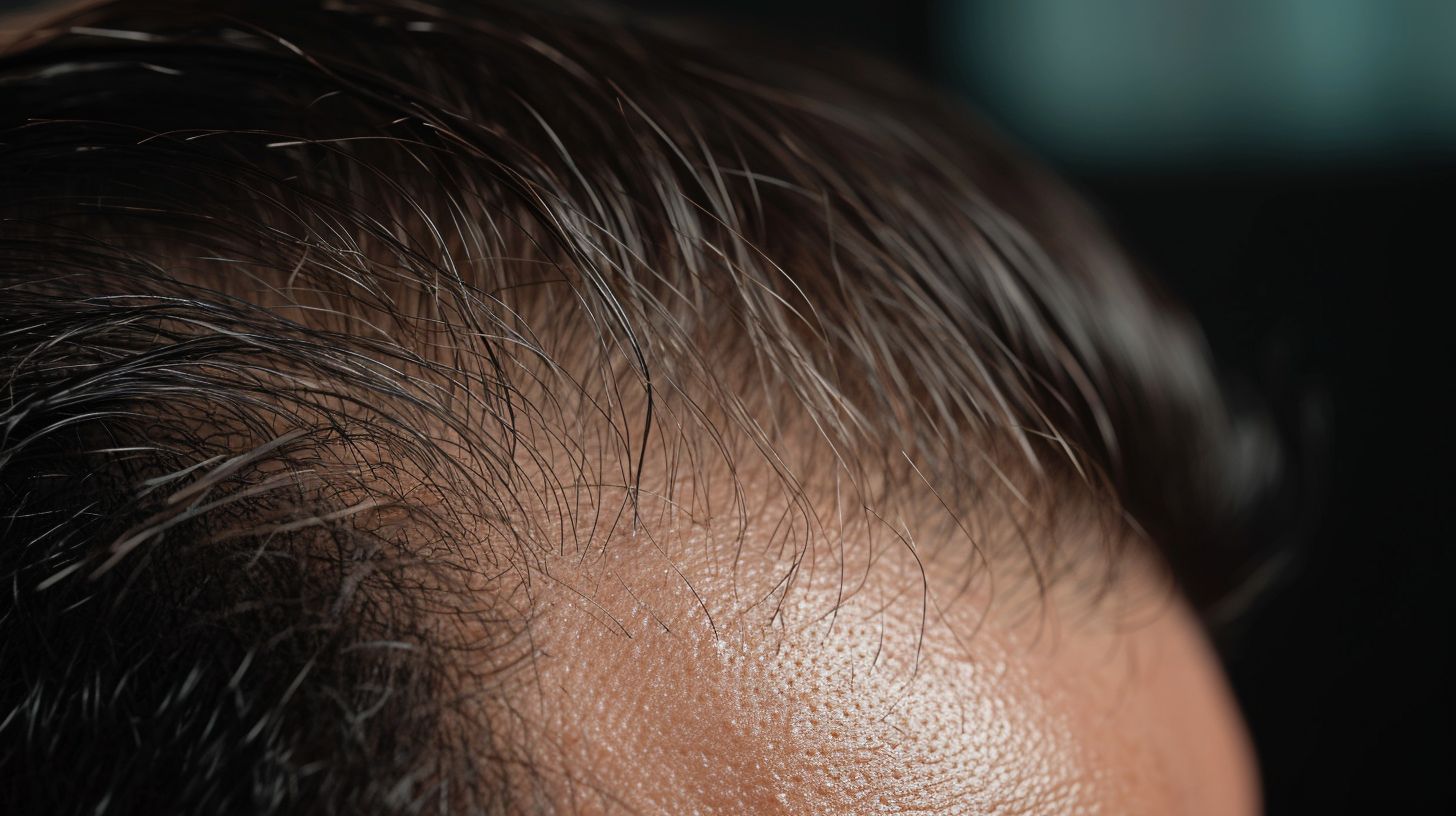

Hair loss can be a distressing experience, particularly when it progresses to male pattern baldness. In South Korea, a landmark study has shed light on how two popular hair loss treatments measure up against each other.
This blog dives into the detailed findings comparing Dutasteride and Finasteride, offering much-needed clarity for those grappling with thinning locks. Keep reading to discover which one could be your ally in the fight against hair loss.
Key Takeaways
- Dutasteride may be more effective than Finasteride in treating male pattern baldness, showing better improvement in hair growth and a lower incidence of adverse events over the long term.
- Both medications are associated with risks of sexual dysfunction and teratogenic effects; pregnant women or those planning to become pregnant should avoid exposure to these drugs.
- The study included 600 male patients from South Korea, carefully selected based on inclusion criteria such as age and confirmed diagnosis of AGA, providing robust data for comparison.
- While both treatments have been shown to be effective, individual responses vary, suggesting that personal medical consultation is crucial before starting either medication.
- Research indicates that dutasteride reduces DHT levels by 98%, compared to finasteride’s 71%, highlighting its potential potency in combatting hair loss.
Overview of Dutasteride and Finasteride

Dutasteride and Finasteride are both medications used to treat male pattern baldness by reducing levels of dihydrotestosterone (DHT), a hormone that contributes to hair loss. Dutasteride works by inhibiting both types of 5-alpha reductase enzymes, while Finasteride selectively targets type II 5-alpha reductase.
Both drugs are FDA-approved for the treatment of benign prostatic hyperplasia, but only Finasteride is approved for the treatment of male pattern baldness.
How they work
Finasteride and Dutasteride tackle hair loss at its hormonal source by blocking the formation of dihydrotestosterone (DHT), a key player in male pattern baldness. These medications are known as 5-alpha-reductase inhibitors because they prevent the enzyme 5-alpha-reductase from converting testosterone into DHT.
High levels of DHT shrink hair follicles, leading to thinner strands and eventually, hair loss.
By lowering these DHT levels, both drugs help protect the hair follicles from further damage. The results can be striking—with fewer shrunken follicles, patients often see a halt in their hair loss and even regrowth in areas that were previously thinning.
Although similar in action, studies indicate that Dutasteride might offer more potent inhibition of DHT than Finasteride, possibly enhancing its effectiveness in promoting scalp hair growth for people with androgenetic alopecia.
Common uses
Dutasteride and finasteride have garnered reputable positions in the arsenal against male pattern baldness. Doctors often prescribe these medications to men seeking a halt to hair loss and even hair regrowth.
Specifically targeting male androgenic alopecia, they work by disrupting the hormone cycle linked to thinning crowns and receding hairlines. Patients from various walks of life find hope in their effectiveness, making them go-to options for those struggling with self-consciousness due to sparse scalps.
Beyond just a cosmetic fix, these drugs contribute significantly to improving quality of life for affected individuals. In regions like South Korea, where dutasteride is officially approved for AGA treatment, many cling to this solution as a beacon of confidence restoration.
Moving forward into the methodology of comparative study provides deeper insight into how these treatments stack up against each other scientifically.
Methodology of the Comparative Study

The methodology of the comparative study involved establishing clear objectives, designing a study that included specific inclusion and exclusion criteria, and collecting data on patient demographics and baseline characteristics.
The study aimed to compare the effectiveness and safety profiles of Dutasteride and Finasteride for male pattern baldness in a comprehensive multi-center setting.
Objectives
Understanding the effectiveness and safety of treatments for male pattern baldness stands at the forefront of this study’s goals. Researchers aim to assess both short-term and long-term results, comparing how well Dutasteride and Finasteride perform in halting hair loss and promoting regrowth.
Crucially, they seek to understand which treatment delivers better outcomes with fewer undesirable effects over time.
Equally important is evaluating adverse events that patients might experience while using these medications. Gathering real-world evidence from South Korean patients who have been treated for at least three years provides valuable insights into the occurrence of side effects and any serious complications associated with each drug.
This comparative study aims to offer those struggling with hair loss a clearer picture of what they can expect from Dutasteride versus Finasteride in terms of efficacy, safety, and overall patient satisfaction.
Study design
Researchers in South Korea meticulously crafted a multi-center study to measure how well dutasteride and finasteride tackle male pattern baldness. They didn’t just want to know if these treatments helped grow hair; they aimed to dig into the specifics of safety, side effects, and overall success rates.
Teams across various centers worked together under strict protocols to ensure every bit of data was comparable, making this research robust and reliable.
Each patient’s journey through the trial was carefully monitored. From their first dose until the last day of treatment, scientists tracked progress and noted any changes with precision.
This approach provided a clear picture of what individuals facing hair loss could expect from each medication over time – focusing squarely on results without ignoring potential risks or downsides.
Inclusion/exclusion criteria
To be included in the study, male patients had to have a confirmed diagnosis of AGA, be 18 or older, and have at least 3 years of available medical charts during the observation period. Exclusion criteria for the study involved individuals who did not meet the inclusion criteria, were female, or had incomplete medical records.
- Male patients with a confirmed diagnosis of androgenetic alopecia (AGA) were included.
- Participants had to be 18 years or older.
- Patients required at least 3 years of available medical charts during the observation period while receiving prescribed treatment.
- Those who did not meet the inclusion criteria were excluded.
- Female patients were not eligible for participation in the study.
- Individuals with incomplete medical records were also excluded from the study.
Patient Demographics and Baseline Characteristics

Understanding the characteristics of participants in clinical studies is crucial, as these details can significantly impact the outcomes and interpretability of the research. In the context of a study comparing the efficacy and safety of Dutasteride and Finasteride in treating male pattern baldness, a comprehensive look at patient demographics and baseline characteristics provides valuable insights. Here are the summarized points outlined in an HTML table format:
| Characteristic | Dutasteride Group (n=295) | Finasteride Group (n=305) |
|---|---|---|
| Number of Participants | 295 | 305 |
| Age Distribution | Older age group | Younger than Dutasteride group |
| Baseline AGA Classification | More moderate/severe cases | Less moderate/severe cases |
This data highlights that the study included a total of 600 male adult patients. The Dutasteride group was older on average, possibly suggesting a longer duration of hair loss or more advanced stages of male pattern baldness. Additionally, this group presented with a higher proportion of moderate to severe androgenetic alopecia (AGA) at the study’s inception. These findings are essential for readers seeking to understand the nuances of such treatments and their potential effectiveness within specific patient groups.
Treatment Patterns for Male Androgenic Alopecia

Dutasteride and Finasteride are two commonly used treatments for male androgenic alopecia, each with its own distinct treatment patterns and effectiveness. To learn more about these treatment options and their effectiveness in combating hair loss, continue reading the full blog.
Dutasteride
Dutasteride significantly improves hair growth in men with androgenic alopecia. It effectively reduces dihydrotestosterone (DHT) levels in the scalp, promoting hair regrowth. Compared to finasteride, dutasteride demonstrates greater effectiveness and tolerability for male patients experiencing hair loss.
With a 98% reduction in DHT levels versus finasteride’s 71%, dutasteride offers a promising solution for combating baldness.
Finasteride
When it comes to treating male pattern baldness, Finasteride is another medication that has been widely studied and used. The study revealed that patients treated with finasteride demonstrated improvements in hair growth, although not as significant as those seen in dutasteride-treated patients.
However, it’s important to note that the rates of adverse events were relatively low for both treatments but showed a slight increase among finasteride users, particularly related to skin conditions.
The findings suggest that finasteride may be effective for some individuals experiencing male pattern baldness while being mindful of potential side effects. It’s essential for individuals considering this treatment to discuss with healthcare professionals about any concerns and weigh the benefits against possible risks before starting any medication regimen.
Comparative Effectiveness of Dutasteride and Finasteride
Both dutasteride and finasteride have shown to be effective in treating male pattern baldness, with each drug having its own unique benefits and potential drawbacks. To learn more about how these two medications compare in terms of effectiveness, safety, and side effects, continue reading the full article.
Long-term effectiveness
Dutasteride has demonstrated superior long-term effectiveness compared to finasteride in treating male pattern hair loss. It consistently shows significant improvement over finasteride, even when accounting for patient demographics and other influencing factors.
This highlights the potential benefits of considering dutasteride as a viable long-term solution for individuals experiencing hair loss.
The data reveals that patients treated with dutasteride had a lower incidence rate of adverse events compared to those on finasteride, further supporting its long-term efficacy and safety profile.
Short-term effectiveness
Dutasteride demonstrates significant short-term effectiveness in promoting hair growth for men experiencing androgenic alopecia. In a multi-centre study, patients treated with dutasteride experienced noticeable improvements compared to those on finasteride, reflecting its swift impact on arresting hair loss and stimulating regrowth.
This real-world evidence underscores the promise of dutasteride as an effective intervention for male pattern baldness.
The comparative study revealed that dutasteride-treated patients exhibited greater improvement in hair growth over a shorter period than those using finasteride. This highlights the potential for individuals dealing with male pattern baldness to opt for dutasteride to yield quicker results, addressing their concerns regarding short-term effectiveness.
Safety Assessment of Dutasteride and Finasteride
The safety assessment of Dutasteride and Finasteride will examine potential side effects and adverse events associated with their use, including sexual dysfunction and impact on fertility.
To learn more about the comparative safety profiles of these medications for male pattern baldness, continue reading.
Potential side effects
Potential side effects of dutasteride and finasteride for male pattern baldness include:
- Sexual dysfunction, such as decreased libido and erectile dysfunction.
- Adverse events related to the use of these medications, which were found to be equivalent in occurrence during the study period.
- Reports of adverse events of special interest during the observational period, which were not statistically equivalent between the two groups but are still noteworthy.
- The incidence of sexual side effects was lower with dutasteride compared to finasteride, indicating a potential advantage in terms of sexual health.
- Adverse events (AEs) occurring due to the use of these medications, including but not limited to testicular pain and ejaculatory dysfunction.
Adverse events
After discussing the potential side effects in the previous section, it’s important to consider the occurrence of adverse events in both dutasteride and finasteride treatments for male pattern baldness. Here are some crucial findings regarding the adverse events observed during the comprehensive study:
- Dutasteride demonstrated a lower incidence of overall adverse events compared to finasteride, indicating its potential for better tolerability and safety profile in long-term use.
- The study revealed that reports of adverse events of special interest were comparable between the two treatment groups, providing valuable insights into the safety considerations associated with both medications.
- Notably, while the overall occurrence of adverse events was not statistically equivalent between the groups, this outcome highlighted specific areas where one medication may offer advantages over the other in terms of tolerability and patient comfort.
- It is essential for individuals considering these treatments to be aware of these differences in adverse event profiles to make informed decisions about their suitable hair loss management options.
Sexual Dysfunction Associated with Dutasteride and Finasteride Use
Both Dutasteride and Finasteride have been associated with sexual dysfunction, but the comparative analysis of these drugs in terms of their impact on sexual health may surprise you.
To learn more about the potential effects of these medications, keep reading!
Persistent symptoms
Persistent symptoms related to sexual dysfunction can significantly impact the quality of life for individuals experiencing male pattern baldness. Dutasteride and finasteride, both commonly used for hair loss treatment, have been associated with persistent sexual side effects in some cases.
However, it is important to note that studies have shown a lower incidence of these symptoms with dutasteride compared to finasteride. Understanding the potential persistence of such symptoms is crucial when considering the long-term use of these medications and making informed decisions about their suitability for individual needs.
The comparative study conducted in South Korea demonstrated that dutasteride was linked to a lower occurrence of persistent sexual side effects when compared to finasteride. This finding suggests that individuals seeking hair loss treatment may benefit from discussing the potential persistence of sexual symptoms with their healthcare providers and considering the comparative safety profiles of these medications before making treatment choices.
Comparison of both drugs in terms of sexual dysfunction
Shifting focus from persistent symptoms, we now delve into the comparative analysis of Dutasteride and Finasteride concerning their impact on sexual dysfunction, a critical consideration for those experiencing male pattern baldness. Here’s how they stack up against each other:
| Dutasteride | Finasteride | |
|---|---|---|
| Incidence of Sexual Dysfunction | Similar rates as Finasteride | Similar rates as Dutasteride |
| Erectile Dysfunction | Reported in some cases | Reported in some cases |
| Libido Decrease | Occasionally observed | Occasionally observed |
| Ejaculation Disorders | Less commonly reported | Reported with similar frequency |
| Long-term Sexual Side Effects | Not significantly different from Finasteride | Not significantly different from Dutasteride |
| Reversibility of Sexual Dysfunction | Often reversible after discontinuation | Often reversible after discontinuation |
| Adverse Events of Special Interest | Equivalent reports to Finasteride | Equivalent reports to Dutasteride |
This table provides a concise summary comparing the sexual side effects of Dutasteride and Finasteride, illustrating that both medications have similar profiles when it comes to the risk of sexual dysfunction. However, individual responses to each medication may vary, necessitating a personalized approach to treatment for male pattern baldness.
Dutasteride and Finasteride and Infertility
The potential impact of dutasteride and finasteride on infertility, including teratogenicity and effects on sperm count, will be discussed in this section. To learn more about the comparative analysis of these two drugs for male pattern baldness, keep reading.
Teratogenicity of Dutasteride
Dutasteride poses potential risks to pregnant women, as it has been linked to an increased risk of birth defects in male fetuses. This is due to the drug’s ability to inhibit the conversion of testosterone into dihydrotestosterone (DHT), which is essential for normal fetal development.
Pregnant women or those planning pregnancy should avoid handling dutasteride-containing medications to prevent any potential harm to the developing fetus. It is crucial for individuals using dutasteride, especially men of reproductive age, and their partners, to implement effective contraception methods while on this medication.
The teratogenicity of dutasteride highlights the importance of careful consideration and communication between healthcare providers and patients regarding its use, particularly in cases where there is a possibility of pregnancy occurring.
Teratogenicity of Finasteride
Finasteride has been linked to potential risks during pregnancy, as it may cause birth defects in male fetuses. It is crucial for women who are pregnant or planning to become pregnant to avoid any contact with finasteride due to the risk of teratogenicity.
Additionally, men taking finasteride should also exercise caution and seek medical advice if their partners are pregnant or may become pregnant soon. These precautions are essential in order to minimize the risk of harm to the developing fetus and ensure a safe pregnancy.
The teratogenic potential of finasteride underscores the importance of informed decision-making when considering its use, particularly for individuals who are actively trying to conceive or could be involved in a pregnancy.
Comparative Analysis of Dutasteride and Finasteride
Dutasteride and Finasteride will be compared in terms of efficacy, side effects, compliance, and financial considerations. To delve deeper into this comparative analysis, read the full blog post!
Efficacy
Dutasteride has demonstrated superior effectiveness over finasteride in improving the BASP classification for treating male androgenic alopecia. This suggests that dutasteride may offer better outcomes compared to finasteride, providing hope for individuals experiencing hair loss.
The study’s findings support the consistent use of dutasteride in clinical practice as a viable option for enhancing treatment outcomes in South Korea.
The results highlight dutasteride as a promising solution for male pattern baldness, potentially offering improved efficacy compared to finasteride. These findings provide valuable insights into the potential benefits of using dutasteride as an effective treatment option for individuals struggling with hair loss.
Side effects
Dutasteride and finasteride may cause sexual dysfunction and decreased libido as common side effects. However, the study indicated that dutasteride has a lower risk of side effects compared to finasteride in the treatment of male pattern baldness.
While specific data on the experienced side effects was not provided, patients treated with dutasteride reported fewer instances of recent hair loss than those on finasteride. It’s important to note that the long-term safety of dutasteride in treating male pattern baldness was supported by the study, suggesting potentially favorable side effect profiles.
Considering these findings, individuals experiencing hair loss might benefit from choosing dutasteride for their treatment regimen, especially if they are concerned about potential adverse reactions commonly associated with finasteride use.
Compliance
While side effects and treatment efficacy are vital considerations when choosing a hair loss medication, compliance with the prescribed regimen is equally crucial. In the comparative study between dutasteride and finasteride, compliance was assessed to determine patient adherence to their respective treatments.
The findings revealed that both groups demonstrated high levels of compliance throughout the observation period. This indicates that patients were diligent in following their prescribed dosing schedule for either dutasteride or finasteride, which is fundamental for achieving optimal results from these medications.
The study’s inclusion of 600 male adult patients highlights robust data on treatment patterns and patient adherence, providing valuable insights into real-world usage of these medications to manage male pattern baldness effectively.
Financial considerations
The study did not delve into comparing the cost-effectiveness of dutasteride and finasteride for male pattern baldness treatment. Economic details, including specific financial data or cost analysis, were notably absent from the study findings.
Consequently, there was no discussion touching on the economic impact of utilizing these medications for treating male pattern baldness.
It’s important to note that this comparative analysis did not include any information regarding financial considerations or economic implications concerning dutasteride and finasteride for male pattern baldness.
Discussion
The discussion section will interpret the findings of the comparative study, providing insights into the clinical implications of using Dutasteride and Finasteride for male pattern baldness.
It will also address ethical considerations in the treatment of male androgenic alopecia, offering a comprehensive analysis to guide future research and clinical practice.
Interpretation of findings
The study compared dutasteride and finasteride in treating male pattern baldness. It found that dutasteride was more effective than finasteride in improving the condition, and both drugs had a similar occurrence of adverse events overall.
The results indicated that dutasteride may be a favorable option for those seeking treatment for male androgenic alopecia, especially for those with moderate to severe symptoms at baseline.
The findings also showed that patients receiving dutasteride were older and had higher severity of male AGA at the start compared to those on finasteride. Additionally, when prescribed at recommended doses, 7.6% of dutasteride-treated patients reported adverse events versus 10.5% of finasteride-treated patients during the observation period.
Clinical implications
Based on the study findings, dutasteride has shown superior effectiveness in promoting hair growth compared to finasteride, particularly for individuals with the most common type of male pattern baldness.
Additionally, although both drugs demonstrated similar rates of overall adverse events, reports of specific noteworthy adverse effects were found to be comparable between the two treatments.
As such, individuals experiencing male AGA may consider consulting their healthcare providers about the potential benefits and risks associated with dutasteride and finasteride when seeking treatment options.
Addressing Ethical Considerations in the Treatment of Male Androgenic Alopecia
The ethical considerations in the treatment of male androgenic alopecia involve evaluating the efficacy, side effect profiles, ease of use (compliance), and cost of using Dutasteride and Finasteride.
It is essential to consider these factors when making decisions about the best course of treatment for male pattern baldness.
Consideration of efficacy
Dutasteride has demonstrated greater effectiveness in promoting hair growth compared to finasteride, especially when used at the recommended dosages. The clearer reduction of serum DHT levels by 98% with dutasteride provides solid evidence of its efficacy for treating male pattern baldness.
This suggests that for individuals seeking a highly effective solution, dutasteride may be the more efficacious option.
Consideration of side effect profiles
After analyzing the efficacy of both dutasteride and finasteride for male pattern baldness, it is crucial to consider their side effect profiles. In a comprehensive multi-center study in South Korea, it was found that adverse event rates were low in both treatment groups.
However, the numerical difference indicated that adverse events were slightly higher among finasteride-treated patients. Interestingly, skin-related adverse events were more prevalent in the finasteride group compared to dutasteride.
This information provides valuable insights into the safety profile of these treatments for individuals experiencing hair loss.
Consideration of ease of use (Compliance)
Ensuring that the chosen treatment is easy to use and fits seamlessly into daily routines improves compliance. Dutasteride has shown good tolerability among male patients with AGA, indicating its potential for ease of use.
By simplifying the administration process and minimizing potential side effects, patients are more likely to adhere to their prescribed treatment regimen. This consideration also takes into account the impact on a person’s quality of life, as a straightforward and hassle-free medication routine can positively influence overall well-being.
In comparison, finasteride-treated patients experienced a higher occurrence of adverse events than those treated with dutasteride. This suggests that dutasteride may offer an advantage in terms of ease of use due to its favorable tolerability profile.
Consideration of cost
Dutasteride may be more effective in promoting hair growth, but it comes with a higher cost compared to finasteride. While the price difference might be a consideration for some individuals, it’s important to weigh the potential benefits against the financial investment.
People dealing with hair loss should carefully evaluate their budget and discuss affordable treatment options with healthcare providers. Making an informed decision that aligns with both financial constraints and treatment goals can lead to a more satisfying outcome in addressing male pattern baldness.
Moving forward, exploring alternative solutions beyond just cost could help provide a holistic approach to managing male androgenic alopecia. By considering various aspects of these treatments, individuals can make informed decisions that prioritize both their health and economic well-being.
Conclusion
In conclusion, the comprehensive multi-center study in South Korea found that dutasteride showed greater effectiveness than finasteride in improving male pattern baldness (AGA) classification and had similar or possibly lower occurrence of adverse events.
The findings from this study have important implications for the treatment of AGA, suggesting that dutasteride may be a more effective option for patients experiencing male pattern baldness.
Summary of key findings
Dutasteride-treated patients experienced greater hair growth improvement compared to those treated with finasteride. Adverse events were not statistically equivalent between the two groups during the observation period.
International guidelines recommend using topical minoxidil (5%) and oral finasteride for male AGA treatment, while dutasteride has shown significantly superior results in hair growth over finasteride.
These findings indicate that dutasteride may be a more effective option for individuals seeking improved outcomes in treating male pattern baldness than finasteride, although further research is necessary to fully understand the implications of these differences.
Implications for future research
Future research should focus on thoroughly evaluating the effects of 5-ARI medications, such as dutasteride and finasteride, on male fertility. It’s essential to address the controversial impact of these drugs on reproduction and gain a clearer understanding of dihydrotestosterone (DHT) in spermatogenesis.
Additionally, further studies are needed to assess the efficacy and safety of both oral and topical forms of dutasteride and finasteride for male pattern baldness.
Understanding the implications of 5-ARIs use on fertility is crucial for individuals considering long-term treatment options for hair loss. Research efforts should be directed towards shedding light on these important considerations to help individuals make informed decisions about their hair restoration treatments.
Final thoughts on the use of Dutasteride and Finasteride for male pattern baldness.
Dutasteride has shown promising results with significantly greater improvement in hair growth compared to finasteride. The study suggests that consistent use of dutasteride may offer an effective and safe treatment option for male patients with androgenic alopecia, potentially outweighing the benefits of finasteride.
Safety profiles between the two treatments were largely equivalent, indicating that both options may be suitable for long-term use in the treatment of male pattern baldness.
The real-world evidence gathered from this multi-centre study in South Korea indicates that dutasteride could be a valuable addition to the arsenal of treatments available for individuals struggling with male pattern baldness, leading to better outcomes over time when used consistently.
FAQs
1. What are Dutasteride and Finasteride?
Dutasteride (Avodart) and Finasteride are prescription drugs that treat male pattern baldness by targeting hair loss at the scalp.
2. How do these medications work for hair loss?
Both Dutasteride and Finasteride improve hair growth by altering the hair cycle, particularly prolonging the anagen phase where the follicular units produce new hairs.
3. Was there a difference in side effects between Dutasteride and Finasteride in the study?
The South Korean multi-centre study conducted rigorous analyses including placebo-controlled trials which found that both drugs may cause similar side effects but their intensity and prevalence require individual examination.
4. Can women use these treatments for female-pattern hair loss?
While primarily studied for male pattern baldness, off-label uses have shown potential benefits in treating female-pattern hair loss under strict medical supervision to monitor any comorbidities.
5. Did the South Korean study mention any concerns regarding depression or post-finasteride syndrome?
Serious adverse events (SAEs), such as depression or post-finasteride syndrome, were closely monitored during controlled trials ensuring patient safety alongside statistical power to provide reliable results about drug administration outcomes.
6. Are there alternatives to taking medication for treating alopecia areata or male pattern baldness highlighted by this research?
Yes, alternative AGA treatments like platelet-rich plasma injections, light therapy, minoxidil application, antiandrogen medications like spironolactone, cyproterone acetate or more permanent solutions such as hair transplantation were reviewed within this comprehensive research.
